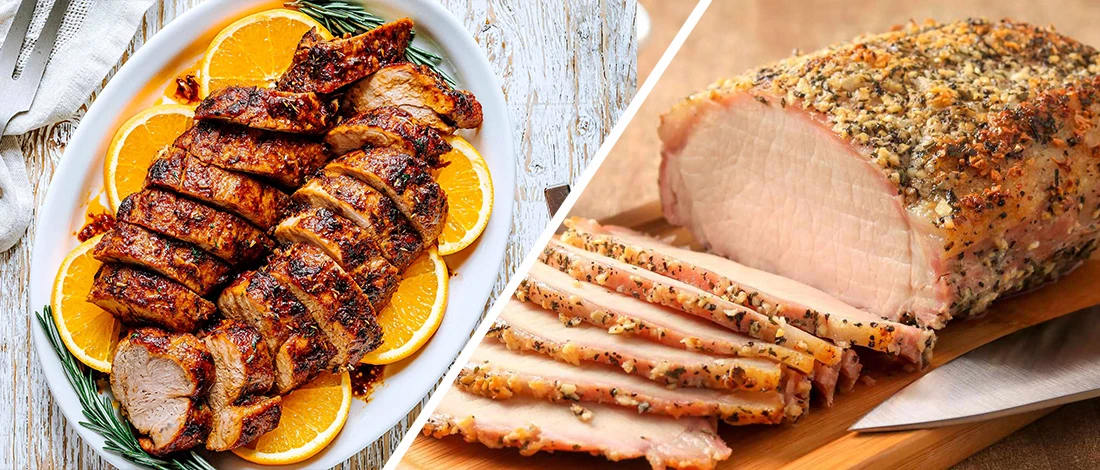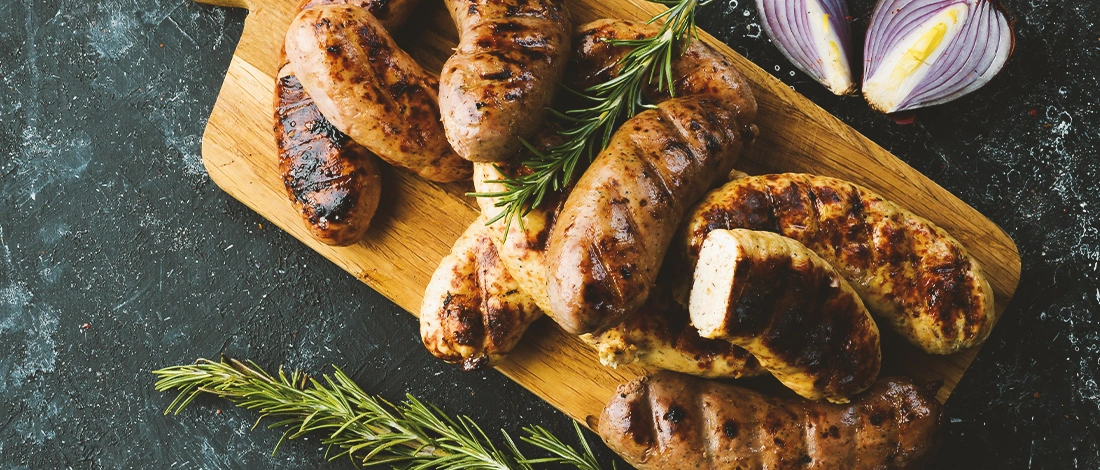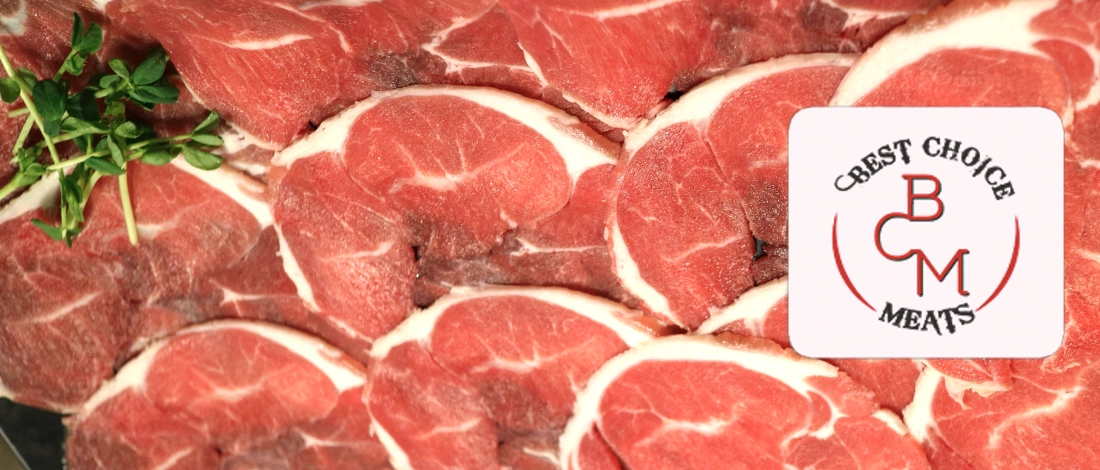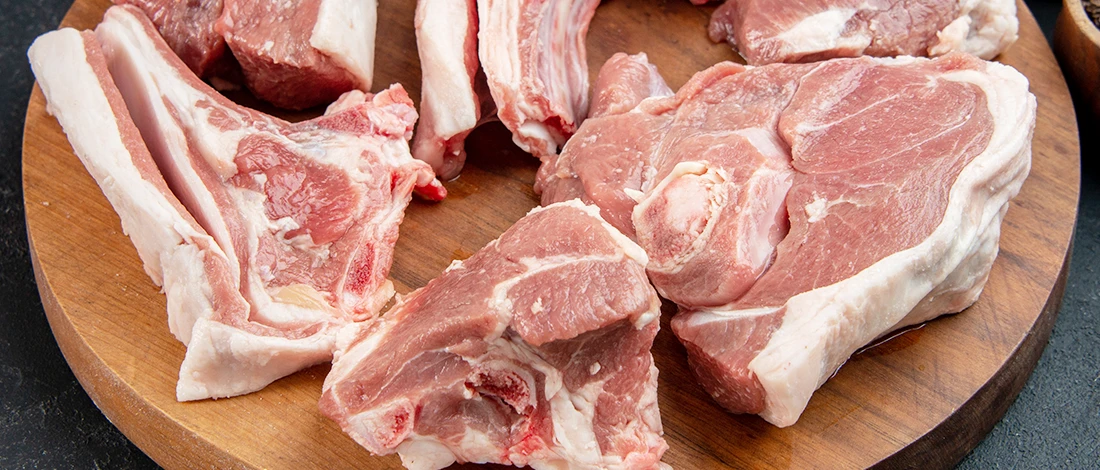Five years into my flexitarian journey, I've primarily focused on white meats. However, the idea of incorporating pork, specifically lean pork loins, recently piqued my interest.
Eager to ensure that this would be a healthy addition to my varied diet, I consulted my dietician for expert nutritional advice.
Today I'll share a comprehensive breakdown of what I learned about pork loin—its nutritional profile, benefits, and how it can fit into a flexitarian diet.
If you're contemplating diversifying your protein sources and considering pork, this guide aims to provide you with the information you need to make an informed choice.
Quick Summary
- Lean pork loin is a pork cut with more protein, fewer calories, and saturated fats.
- Pork loin has complete protein content because it has all the essential amino acids.
- Eating undercooked pork loin increases the risk of foodborne diseases like trichinosis.
Calories in Pork Loin
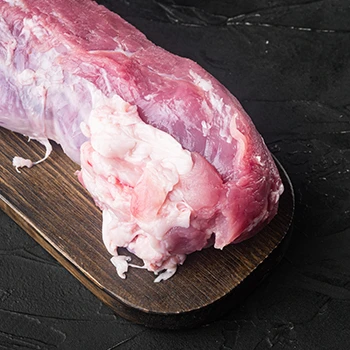
How many calories are in pork loin? When comparing pork loin's nutrition with other pork cuts like the shoulder, pork loin has fewer calories, less fat, and more nutrients like potassium and calcium.
A 100g pork loin serving has 192 g of calories, 79 g of which accounts for fat. 85 g of the same has 168.5 calories, with 58.5 g being fat.
I found that you can easily burn such a calorie amount by swimming for at least 20 minutes.
Pork loin is one of the leanest cuts of pork meat. And while most lean pieces of meat are often dry and chewy, pork loin is juicer and more tender.
You can get your pork loin as a whole T-shape roast or pork chops. I prefer bone-in tenderloin as it is thicker than boneless pork chops.
If you're looking for an authentic and reliable place to source organic pork meat, make sure to check out our review of ButcherBox, a meat delivery company that’s made its mark as a leading brand when it comes to product quality, the ordering process, and timely delivery.
Related Articles:
Other Pork Loin Nutrition Facts

Here's a complete breakdown of other nutrition facts about lean pork loin meat.
1. Protein
Pork loin is a rich source of complete protein since a 100g serving contains 26g.
In other words, this lean pork meat has all the essential amino acids [1].
The same serving has the following:
- Tryptophan: 400 mg
- Threonine: 1300 mg
- Isoleucine: 1400 mg
- Leucine: 2400 mg
- Lysine: 2600 mg
- Methionine: 800 mg
- Cystine: 300 mg
- Phenylalanine: 1200 mg
- Tyrosine: 1200 mg
- Valine: 1500 mg
- Arginine: 1900 mg
2. Carbs
Lean pork loin has 0 g net carbs per serving, just like all other meat products.
The little carbohydrates are available in the form of glycogen which then degrades once the animal is killed during slaughter.
3. Fat

Monounsaturated fat makes up the majority of fat in pork loin, with tiny quantities of saturated and very little polyunsaturated fat.
Purely boiled lean pork loin without additional ingredients offers around 8.8 g per 100 g serving or 14% of the daily value (how much a nutrient in a food serving size contributes).
Out of this:
- Monounsaturated fat: 3.5g
- Saturated fat: 2.8g
- Trans fat: 0.1g
- Polyunsaturated fat: 1g
4. Vitamins and Minerals
Apart from protein, pork loin is also high in a variety of vitamins and minerals, such as:
- Iron: Iron levels in pork tenderloin are lower than in red meat. A 3-ounce pork loin serving has 0.7 mg of iron, which is more easily digestible than iron from plant foods.
- Thiamine. Unlike other varieties of red meat, such as beef and lamb, pork loin is high in thiamine, one of the B vitamins required for many body activities. 100 g of pork loin serving contains 0.99 mg of thiamine.
- Selenium: Selenium is abundant in pork loin. 100g serving has 12.4μg selenium, which accounts for around 18% of the daily value.
- Zinc: Zinc is an essential element found in pork tenderloin. The 1 mg of zinc in every 100g food serving is required for a healthy brain and immune system [2]. This nutrient content contributes to 7% of the daily value.
- B12 vitamin: 100g of pork loin has a 10% daily value of Vitamin B12, a nutrient that’s almost absent in many animal diets.
Post You May Like: Best Supplements for the Carnivore Diet
Benefits and Shortfalls of Eating Pork Loin

Let's look at some of the benefits and shortfalls of including this lean pork cut into your dietary routine.
1. Great Protein
Regarding nutrition facts, pork loin is like a natural protein powder because it's a good source of high-quality, complete food protein. You're consuming adequate amounts of all amino acid nutrients when you eat pork loin.
Also Read: What Meat Has the Most Protein?
2. Excellent Vitamin Source
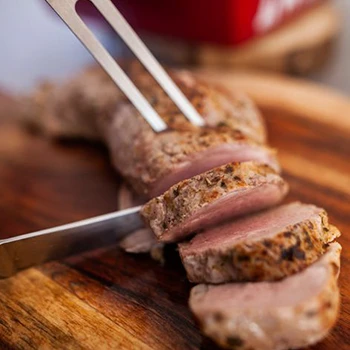
Pork loin is abundant in vital vitamins like vitamin C, B6, and B12.
Vitamin B6 is essential for the body's red blood cell production, nervous system regulation, and cognitive function [3]. This is critical in reducing the likelihood of succumbing to anxiety and other cognitive dysfunctions.
Vitamin B12 is essential for forming and maintaining nerve and red blood cells, nourishing the neurological system, and aiding DNA formation. Anemia can develop if vitamin B12 deficiency is not treated [4].
3. Adequate Glycine Levels
Glycine is found in high concentrations in pork loin. For every 100 grams of tenderloin serving size, it contains 1300 milligrams of glycine.
“Glycine is an amino acid used to create protein in the body.”
- Gavin Van De Walle, Registered Dietician
4. Excellent Selenium Source
One of the minerals contained in lean pork loin food is selenium essential for thyroid function. 100g of pork loin serving contributes up to 18% of the daily value.
5. Trichinosis Risks

Eating infected or undercooked lean pork loin puts you at risk for trichinosis, a parasite illness.
Trichinosis is caused by a roundworm bacterium that enters and infects our intestines and organs. Its symptoms might include nausea, stomach discomfort, and inflammation [5].
Fortunately, you can avoid this risk by cooking your lean pork loin properly. I recommend cooking your pork loin and all other pork meat at 163°F (71°C) as this helps eliminate any parasites present in the meat.
6. High Omega-6 to 3 Ratio
An overabundance of pro-inflammatory omega-6 in your daily diet may induce inflammation-related health issues [6].
Pork loin has substantially greater omega-6 to 3 nutrient ratios than other meats like bone steaks, fish, and chicken.
FAQs
How Many Nutrient Calories Are in One Ounce of Pork Loin?
There are 34 nutrient calories in one ounce of pork loin.
Is Pork Loin Good For Weight Loss?
Yes, pork loin is good for weight loss because it has high protein, 0 g net carbs, and less saturated fat.
Does Cooked Pork Loin Have More Nutrients than Raw Pork Loin?
Yes, cooked pork loin has more nutrients than raw pork loin because of the extra ingredients that are used for cooking. For example, the total fat in raw pork loin is less than that in a cooked loin because extra oils are used for cooking it.
References:
- https://tools.myfooddata.com/protein-calculator/167820/wt1/1
- https://www.mayoclinic.org/drugs-supplements-zinc/art-20366112#
- https://medlineplus.gov/ency/article/002402.htm
- https://www.hsph.harvard.edu/nutritionsource/vitamin-b12/
- https://www.health.ny.gov/diseases/communicable/trichinosis/fact_sheet.htm#
- https://www.ncbi.nlm.nih.gov/pmc/articles/PMC3335257/

